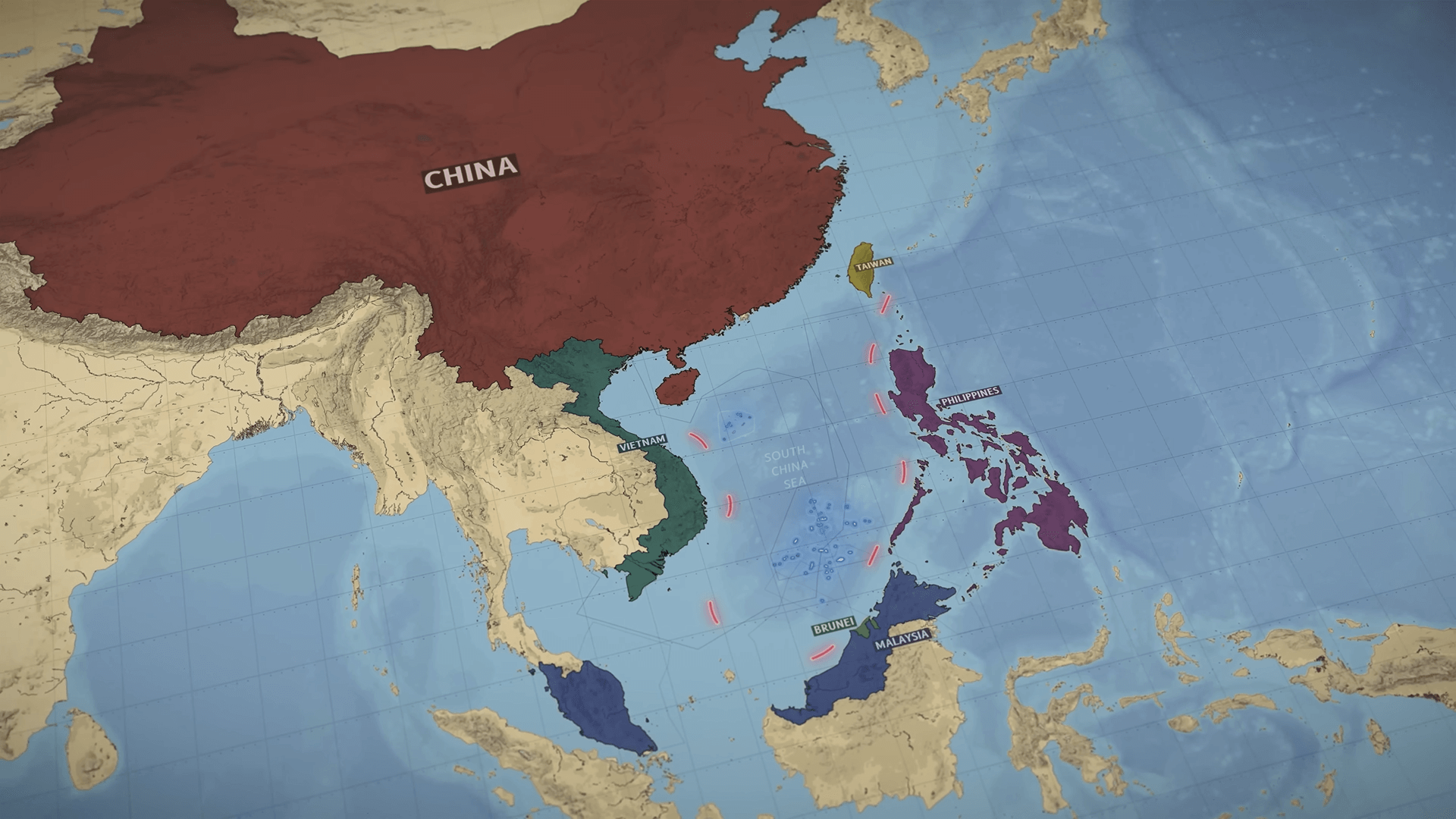The United States is adopting a more robust approach regarding its relationship with China. Could the situation in the South China Sea escalate further?
Since the Munich Security Conference at the latest, it has become evident that the USA envisions its future in the Indo-Pacific amid the geopolitical rivalry with China. The newly appointed US Secretary of State, Marco Rubio, is meticulously strategizing to ensure robust relations with China. During his initial discussion with chief diplomat Wang Yi, Rubio expressed strong criticism of Beijing’s assertive maneuvers in the Indo-Pacific region. Wang Yi swiftly responded and sharply criticized Rubio. He ought to conduct himself appropriately and select his words with precision. However, Rubio remained undeterred by this. Shortly thereafter, he reassured the US allies in the region of the unwavering support from the United States.
This establishes the framework for the new US administration as it engages with China in the Indo-Pacific region. Beijing perceives the robust US military presence along the initial Pacific island chain, which includes the Kuril Islands, Japan, Taiwan, the Philippines, and Borneo, as a significant threat to crucial trade and supply routes. To bolster its strategic standing, China is actively seeking to enhance its influence in the region.
From the viewpoint of the United States, it is this very ambition that presents a danger to the second (Japan – Guam – Caroline Islands – West New Guinea) and third Pacific island chains (Aleutian Islands – Hawaii – New Zealand), along with the American mainland. The South China Sea, a vital route for approximately 20 percent of global trade, serves as a battleground for the competing interests of the two superpowers.
The intricate disputes among neighboring nations regarding the control of islands, archipelagos, and reefs in the South China Sea have resulted in a notable rise in militarization in the area over the past few years. China asserts extensive territorial claims, laying claim to approximately 80 percent of the South China Sea based on historical references and ancient maps, commonly referred to as the Nine-Dash Line. This would significantly reduce the exclusive economic zone of neighboring states by as much as 80 percent, resulting in the loss of abundant fishing areas, valuable resource deposits, and strategically crucial locations. Conflicts involving coast guards, paramilitary forces, and fishing boats continue to be a persistent issue. An observable trend of predominantly Chinese initiatives eliciting responses is taking shape. Analysts describe a “gray zone tactic” employed by Beijing to establish de facto control over contested territories, all while avoiding military confrontation.
The Philippines is advocating for the internationalization of the conflict, grounded in the principles of the United Nations Convention on the Law of the Sea (UNCLOS). In 2013, the Philippines launched arbitration proceedings at the United Nations Permanent Court of Arbitration located in The Hague. The 2016 arbitration ruling saw the court backing the Philippines while dismissing China’s assertions linked to the Nine Dash Line, grounded in international maritime law. The judges expressed their disapproval of China’s actions, highlighting the violation of the Philippine exclusive economic zone through the deployment of ships, the enforcement of fishing moratoriums, and the construction of artificial islands. Nonetheless, the Permanent Court of Arbitration lacks the authority to determine border lines.
While the arbitration award holds legal weight, it lacks recognition from China. Alongside China, Russia, Cambodia, Laos, and Pakistan, among others, have dismissed the ruling. Conversely, the USA, Japan, Australia, and Vietnam stand in solidarity with the Philippines, advocating for adherence to international law. The German government has once again expressed its backing for UNCLOS and the arbitration award in the wake of a violent confrontation between the Chinese and Philippine coast guards in June 2024.
The current situation suggests that a resolution to the conflict is not imminent. In November 2024, President Marcos Jr. of the Philippines enacted two laws aimed at bolstering the country’s territorial claims in accordance with UNCLOS. In a predictable turn of events, Beijing expressed strong indignation and heightened its patrols in the contested maritime region.
In December 2024, the Philippines declared its intention to gather evidence for a new case against China to present before a UN body. The Philippines has been depending on a “transparency initiative” for a while now: the actions of China in the contested maritime region will be disclosed to attract global allies to uphold the 2016 arbitration ruling.
The situation presents a delicate equilibrium for each of the nations adjacent to the South China Sea. Numerous nations in the area uphold strong ties with the two dominant global powers, the USA and China. Although China frequently stands as the primary trading partner, the United States is pivotal in its role as a security guarantor.
In 2024, the Philippines recorded a trade volume of 71 billion US dollars with China, while its trade with the USA amounted to only 21 billion US dollars. Nonetheless, the Philippines maintains a connection through an alliance treaty with its former colonial power, the USA, which has assured mutual support in case of an attack since 1951.
In 2014, the partnership was bolstered by an Enhanced Defense Cooperation Agreement (EDCA), which encompasses the deployment of American forces, collaborative exercises, and training on US military equipment. This indicates that the Philippines relies on both Beijing and Washington. A definitive ruling favoring one party could trigger significant disruptions.
Three potential scenarios emerge regarding the future of the South China Sea. Initially, the most appealing yet least probable outcome, considering the geopolitical tensions and clashing interests in the area, is a diplomatic resolution. This could potentially be achieved through a binding code of conduct established between China and the Organization of Southeast Asian Nations (ASEAN), which would incorporate a mediation mechanism.
Secondly, the dire possibility of unintended escalation appears improbable at this time, despite the substantial presence of security forces and ongoing clashes that present a notable risk. Thirdly, it is probable that the current unsatisfactory state of fragile and tense stability will persist.
This situation indicates a baseline of stability; however, it simultaneously undermines international law, as the UN Convention on the Law of the Sea and the decisions of the Permanent Court of Arbitration remain unimplemented.
From the viewpoint of the Philippines, this validates China’s employment of intimidating actions and provocations to achieve its political objectives. There is an underlying anxiety echoing behind closed doors in the Philippines regarding the reliability of the alliance with the USA in uncertain times. The alliance treaty between the USA and the Philippines intentionally remains ambiguous regarding the specifics of mutual support in times of crisis.
The future of US policy towards the alliance commitment to the Philippines under Trump is still uncertain, particularly in terms of maintaining strategic ambiguity. Marco Rubio’s critical remarks about China shouldn’t distract from the reality that within Trump’s inner circle, there exists a prominent supporter of Beijing in Elon Musk.
This raises concerns about the potential for Trump to be swayed into endorsing dubious “deals” with China that could adversely affect third parties. Nonetheless, Manila finds optimism in Trump’s initial term as president. In 2017, Trump made a visit to the Philippines, during which he referenced a “property in a prime location”. In 2019, the Trump administration explicitly stated that the mutual assistance agreement extends to the South China Sea and the Philippine troops deployed in that region. The Philippines’ status as a significant customer of the US arms industry is likely to bolster ongoing support from the United States.
Despite the slim chances of breaking the impasse in the South China Sea, it is imperative that initiatives aimed at achieving a peaceful resolution persist. Europe has the potential to play a significant role in promoting adherence to international law.
This is relevant not just for established maritime nations like the UK, France, and the Netherlands, but also for Germany. The 2020 Indo-Pacific Guidelines advocate for a peaceful resolution grounded in UNCLOS, acknowledge the “significant importance” of the 2016 arbitration ruling, and endorse a binding code of conduct between ASEAN and China.
In September 2024, Germany demonstrated a significant commitment to international maritime law as the frigate Baden-Württemberg navigated the Taiwan Strait for the first time in 22 years. Just prior to this, the Federal Defense Minister Pistorius made history as the first German defense minister to set foot in the Philippines.
In collaboration with his Filipino counterpart, he unveiled a security agreement focused on enhancing cooperation in the training of the armed forces. In the Philippines, optimism surrounds the potential expansion to encompass arms exports and technology transfers.
The collapse of the traffic light coalition resulted in the failure to finalize the German-Philippine security agreement. The incoming German government is presented with a prime opportunity at the outset of its term to reinforce Germany’s dedication to a rules-based order in the Indo-Pacific.
The author Dr. Niels Hegewisch is a political scientist and is the chief of FES’ Pakistan branch.










+ There are no comments
Add yours